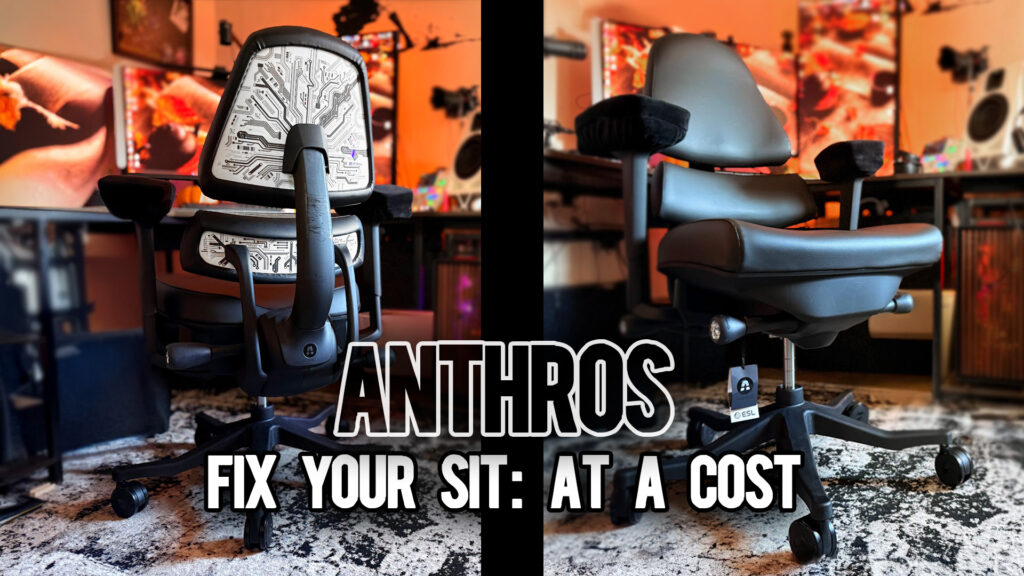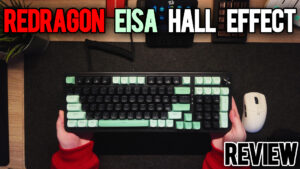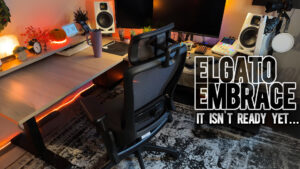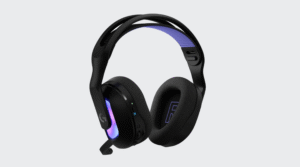Anthros Chair Review: 6 Months Later + An Unfiltered Interview With The Creator

🪑 Anthros Chair — 10% off: https://glnk.io/2o78n/crafting-worlds
TL;DR (Why this chair, why now)
I’ve spent six straight months in the Anthros, and then sat down for a long, no-BS podcast with its creator. Bottom line: it actually does what it promises — “Fix Your Sit.” The 6% lock position and medical seating DNA (from wheelchairs) shift load off your sit bones and into a supported spine. It’s the first chair that let me game/work for marathon sessions without tailbone flare-ups or post-session back regret.
It’s also expensive and not perfect. I call out QC/finish quirks (sticky over-mold knobs, arm pads that collect oils, scuff-prone spine plastics, base aesthetics) that other short-term reviews missed. To Steve’s credit, he addresses the trade-offs and explains what’s being improved (arms/headrest roadmap, modular parts, and why they chose glass-filled nylon and NA manufacturing).
If comfort and pain relief are your #1, this is the best task chair I’ve used. If immaculate cosmetics for $2K are a hard requirement, the finish choices may bug you.
What “Fix Your Sit” Means (6% & 16% in practice)
- 6% Lock: Set the tilt to a shallow ~6–7° recline and lock it there. In testing with ~200 humans, this angle was the universal “relaxed but task-ready” sweet spot. It keeps your torso stacked, reduces core strain, and discourages that unconscious hunch toward the monitor.
- 16% Tilt: Go deeper when you need pressure off the pelvis/sit bones. The load shifts to your lumbar and upper-back pads; blood flow improves past ~15°. It’s a recovery position for long sessions. I still wish there were a matching headrest here (more on that later).
Wheelchair-Tech Seatpan: Why my sit bones stopped screaming
The seat uses licensed medical seating technology: two “domes” (negative cavities) under the sit-bone zones so you don’t bottom out. Add a low-friction liner (think GlideWear-style layers) and you reduce pressure and shear—the same enemies wheelchair cushions are built to fight. The result is the first gaming/editing marathon where I didn’t feel the clock ticking on my tailbone.
Fabric vs Faux Leather (my take after months):
- Faux leather: holds cushion taut longer and delays that “sink” sensation, but runs hotter.
- Fabric: breathes better on the back, but allows a bit more stretch/sink over hours; comfort is still good, just stand and reset occasionally.
My favorite combo if they let you mix: fabric back + leather seat.
The Back System: Two panels, one mission
- Lower lumbar is highly adjustable (gentle to aggressive).
- Triangular upper back nests into the scapular region and encourages that stacked posture without feeling pokey.
- Together they act like a modular spine, moving load away from the pelvis while keeping you upright.
Adjustability, Fit & Tall-User Reality
- Arms: height / depth / width / rotation (classic 4D). I use gel sleeves for plushness, but the stock pads are above average.
- Seat pan is wide, easy to “one-leg up” without fighting the bolsters.
- Tall folks: this is the tall-person chair I recommend right now. The catch: desk height is often the real problem, not the chair. Anthros ships a footrest; use it to raise the chair until your forearms meet the desk without shrugging your shoulders. Your neck will thank you.
Modularity & Repairability (and the headrest roadmap)
The chair is refreshingly modular: back plates, seat, arms—two screws and you’re done. That means:
- Field repairs are simple (and fast under warranty).
- Upgrades (new arms, future headrest) should be backwards-compatible. Steve lays out the plan in the podcast.
- There’s even a tool clipped under the seat for future you.
The QC/Finish Conversation (what most reviews missed)
These don’t break the chair, but you should know:
- Over-molded knobs (newer grippy black style) grab skin oils/dust and look grimy fast. Functionally great; visually meh.
- Arm pad surface can also collect oils—cleanable, but a housekeeping item.
- Rear spine plastic scuffs easily if it taps a desk edge.
- Base finish: they use 50% glass-filled nylon for strength (BIFMA 5.11 @ 400 lb), which can show flow/glassing texture. It’s intentional for durability, not a “polish showpiece.”
In the podcast, Steve accepts the feedback (and shares why those choices were made), and he commits to iterate—especially on arms and headrest. That responsiveness matters at this price.
Price, Warranty & Where It’s Made
- Price: It’s in Aeron/Leap/Embody territory. You’re paying for medical seating know-how, modularity, thick cushion with anti-shear layers, and North American manufacturing/assembly.
- Warranty: 12 years. The modular design keeps service simple.
- Sourcing reality: Cylinders/casters are global like everyone else; foam, plastics, and assembly are largely NA. They chose function > showroom gloss on parts like the base to meet strength targets.
Six Months In: My honest take
- When my cousin and I finished a sweaty boss fight, his back hurt; mine didn’t. I was still in posture-perfect 6%—that never happens on typical chairs.
- Sciatica relief has been real for me. I still stand, but I don’t feel forced to.
- I still want a headrest, especially for the 16% “recovery” position. It’s on their roadmap and should clip to existing chairs.
Would I buy it with my own money? Yes, because it changed my day-to-day comfort and training recovery. But if showroom-level cosmetics are your top priority at $2K, you’ll nitpick the finish choices.
Who Should/Shouldn’t Buy
Buy if…
- You prioritize pain relief, posture, and long-session comfort.
- You’re tall or have had a hard time getting shoulders/elbows aligned with desk height.
- You value repairability and future upgrades (headrest/arms).
Skip or wait if…
- You need perfect cosmetics over function at this price.
- You live in hot climates and hate warm backs → choose fabric back (or wait for mesh models—if they ever do one).
- You must have a headrest today (it’s coming; not here yet).
Setup Tips That Actually Matter
- Raise the chair until your elbows float naturally at desk height; use a footrest to support your feet.
- Lock 6% for focused work and gaming.
- Use 16% when your sit bones or sciatic nerve need a break; you’ll feel the pressure shift to your back pads.
- Dial lumbar from mild → firm over the first week as your body adapts.
- If arm pads feel firm, add gel sleeves—great on long edit/gaming days.
Watch the Podcast with the CEO and Owner of Anthros for more insight
Pros & Cons
Pros
- Legit pressure + shear reduction from medical seating tech
- 6% lock keeps you upright, focused, pain-free longer
- 16% tilt is a great “recovery” posture mid-session
- Tall-user friendly,
- Wide seat,
- Easy leg positions
- Modular, repairable, upgrade path (headrest/arms), tool included
- NA manufacturing
- 12-year warranty
Cons
- Cosmetic nitpicks: sticky over-mold knobs, oil-loving arm pads, scuffable spine plastic, base texture not showy
- Faux leather runs warm; fabric seat stretches a touch more over time
- No headrest… yet (confirmed roadmap)
Alternatives & Context
- Herman Miller Aeron: iconic mesh, cooler feel, narrower fit; higher peak pressures under sit bones in my experience.
- Steelcase Leap V2: adaptive back, great adjustability; pressure relief not as pronounced on long gaming/editing grinds.
- Herman Miller Embody: Not a clue, they have not sent me one 🙁
- Haworth Fern: Piece of shit.
If you’re coming from Leap V2, Aeron, Embody, or Fern, the Anthros feels different—more like a purpose-built medical-leaning task chair than a generalist office icon.
FAQ
Does it need a headrest?
Not to work well, but yes, I want one for 16%. It’s on the roadmap and should work with current frames.
Which material should I pick?
- Hot room / sweaty back → Fabric back, consider leather seat.
- Max seat tautness → Leather seat (but warmer).
Is it good for short users?
It can be set up for shorter folks, but be strict with foot support so shoulders don’t shrug to reach the desk.
Final Verdict
If you’ve tried the usual suspects and still fight tailbone/back/neck fatigue, the Anthros is the first chair I’ve used that fundamentally changes the way I sit. It’s not a lounge throne. It’s a human-body machine tuned for posture and pressure relief, created by someone who built seating for people who can’t get up when it hurts.
Is it worth $2K? If pain relief and posture are your priority: yes. If flawless cosmetics are non-negotiable at that price: you’ll notice the concessions. I’d still buy it for what it does to my day.




